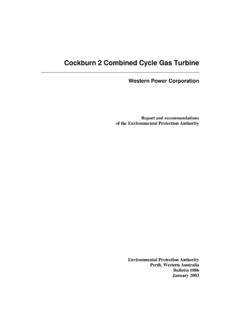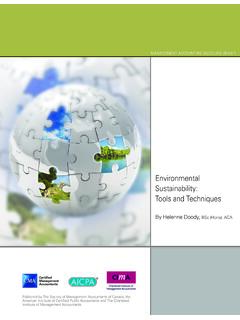Transcription of Environmental Factor Guideline
1 The Environmental objective of the Greenhouse Gas Emissions Factor is: To reduce net greenhouse gas emissions in order to minimise the risk of Environmental harm associated with climate purpose of this Guideline is to outline how and when the Greenhouse Gas Emissions Factor is considered by the Environmental Protection Authority (EPA) in the Environmental impact assessment (EIA) , the Guideline : describes why the EPA has published the Guideline outlines how EPA guidelines are applied provides background on the Greenhouse Gas Emissions Factor identifies activities that may be considered under this Factor describes how this Factor links with other Environmental factors outlines when the EPA may apply this Guideline describes EIA considerations for this Factor provides a summary of the information required by the EPA to undertake EIA relatedto this Factor (including consideration of scope 1, 2 and 3 emissions) outlines periodic public reporting requirements identifies issues commonly encountered by the EPA during EIA of this Factor outlines the timeframes for reviewing this does the EPA need an Environmental Factor Guideline for Greenhouse Gas Emissions?
2 Under section 15 of the Environmental Protection Act 1986 (EP Act), the EPA has the objective to use its best endeavours to protect the environment and to prevent, control and abate pollution and Environmental harm. One way in which the EPA discharges this objective is to assess proposals referred to it under Part IV of the EP Act. The reports that the EPA produces following these assessments must set out what the EPA considers to be the key Environmental factors identified in the course of the assessment, the EPA s recommendation as to whether the proposal may be implemented, and (if the EPA recommends that implementation be allowed) the conditions and procedures that should apply to that Guideline provides guidance on when greenhouse gas (GHG) emissions will be considered to be a key Environmental Factor and how this Factor will be dealt with in the EPA s assessment 2020 1 Greenhouse Gas Emissions Environmental Factor GuidelineEnvironmental Protection AuthorityAirEnvironmental Factor Guideline .
3 Greenhouse Gas Emissions2 The section 15 objective, combined with the established link between GHG emissions and the risk of climate change, and the broad acknowledgement that the warming climate will impact the Western Australian environment, means that the EPA can consider the effects of proposals which would increase the State s emissions, and contribute to Environmental are EPA guidelines applied?The intent of EPA guidelines is to inform the development and assessment of a proposal, not determine the outcome of the EPA s assessment. In the end, each proposal is assessed on its individual merits. These guidelines do not bind EPA assessments; they are explicitly not intended to be predictive of EPA guidelines do not seek to unnecessarily duplicate other regulatory approaches.
4 The approach outlined in our guidelines will be applied with regard to evolving state and national policy settings or new international commitments. The EPA will take contemporary policy settings or commitments into account as it undertakes its assessments, and will update its guidelines if these settings or commitments change significantly and are greenhouse gases and what is their relationship to Western Australia s environment?This Guideline relates to the six categories of greenhouse gases covered by the United Nations Framework Convention on Climate Change (UNFCCC) Reporting guidelines on Annual Inventories. These gases are carbon dioxide (CO2), methane (CH4), nitrous oxide (N2O), sulphur hexafluoride (SF6), hydro fluorocarbons (HFCs) and perfluorocarbons (PFCs).Australia is currently contributing around per cent of global GHG emissions1.
5 Australia s emissions for the year to March 2019 were approximately 540 million tonnes carbon dioxide equivalent (CO2-e), up per cent on the previous year, primarily due to increased liquefied natural gas (LNG) exports2. This is only per cent below emissions in 20052, and the National Inventory Reports 2014 to 2017 indicate that Australia s GHG emissions have risen each year since 2017, Western Australia (WA) contributed million tonnes CO2-e, which is a 23 per cent increase from 2005 levels4. The State Greenhouse Gas Inventory show a steady increase in GHG emissions in WA from the early 1990s. Generally, emissions growth in WA is expected to continue in the short to medium UNFCCC provides the framework for international cooperation to reduce global GHG emissions and limit temperature increases.
6 The UNFCCC Paris Agreement entered into force on 4 November 2016 and Australia is currently committed to reducing GHG emissions by 26 to 28 per cent below 2005 levels by 2030. The Paris Agreement states that net zero emissions will be required in the second half of the century to achieve its goals of limiting warming to well below two degrees Celsius above pre-industrial levels5. More recently, the Intergovernmental Panel on Climate Change s (IPCC s) report indicated that global emissions need to fall by about 45 per cent from 2010 levels by 2030, reaching net zero around 2050, to limit global warming to degrees World Resources Institute (2017, April 11). CAIT Climate Data Explorer. Retrieved from: Quarterly update of Australia s National Greenhouse Gas Inventory for March 2019.
7 Retrieved from Volume 1 - National Inventory Reports 2014 to 2017 (Total net emissions (excluding LULUCF)). Retrieved from #national4 State and Territory Greenhouse Gas Inventories The Paris Agreement, United Nations Framework Convention on Climate Change, Factor Guideline : Greenhouse Gas Emissions3 Locally, the Government of Western Australia released the State Greenhouse Gas Emissions Policy for Major Projects (State Emissions Policy) in August 2019. The State Emissions Policy commits the State Government to working with all sectors of the Western Australian economy to achieve net zero GHG emissions by 2050, and commits to working with the Australian Government s interim target of emission reductions of 26 to 28 per cent by 2030. The State Emissions Policy contemplates that proponents of projects with significant emissions may develop GHG management plans that detail their contribution towards achieving net zero emissions by 2050.
8 The State Emissions Policy declares that local innovation and local benefits are encouraged, particularly in the development of carbon offsets, and indicates a willingness to consider credible international offsets to limit abatement further recognition of the role that climate change is having on the Western Australian environment, and reflecting the growing public interest in this matter, the Government of Western Australia released its Climate change in Western Australia Issues Paper in September 2019. The State Government has also committed to developing a State Climate Policy based on this issues paper in and international greenhouse gas reporting standards define a set of distinct classes (scopes) of GHG emissions that delineate sources and associated responsibilities.
9 Scope 1 GHG emissions are the emissions released to the atmosphere as a direct result of an activity, or a series of activities at a facility level. Scope 2 GHG emissions are the emissions from the consumption of an energy product. Scope 3 emissions are indirect GHG emissions other than scope 2 emissions that are generated in the wider community. Scope 3 emissions occur as a consequence of the activities of a facility, but from sources not owned or controlled by that facility s that may be considered under this factorDevelopment activities that may be considered under this Factor include, but are not necessarily limited to: the extraction, processing and refining of oil and gas the burning of fossil fuels for energy production mining and processing of metallic and non-metallic minerals waste to energy plants infrastructure development chemical manufacturing and processing development that clears this Factor links with other Environmental factorsThe EPA recognises that there are inherent links between the Greenhouse Gas Emissions Factor and other Environmental factors through effects on climate.
10 For example, climate change has already caused a significant drying of the State s south-west, which in turn places significant additional pressures on water resources, flora and fauna, marine Environmental quality, and social Guideline addresses one of the major causes of a changing climate, however the potential impacts of changes in our climate will be considered under each relevant Factor . EPA guidance with respect to maintaining air quality and minimising emissions for human health and amenity are dealt with in the Air Quality Clean Energy Regulator (20 July 2018). Greenhouse gases and energy. Retrieved from Environmental Factor Guideline : Greenhouse Gas Emissions4 When the EPA may apply this guidelineGenerally, the geographic scope of the EPA s obligations is the State of Western Australia and its EPA will have regard to this Guideline when assessing new proposals (including expansions) and changes to proposals resulting in an increase in GHG emissions, which may involve the EPA in the reconsideration of GHG , GHG emissions from a proposal will be assessed where they exceed 100,000 tonnes of scope 1 emissions each year measured in CO2-e.









